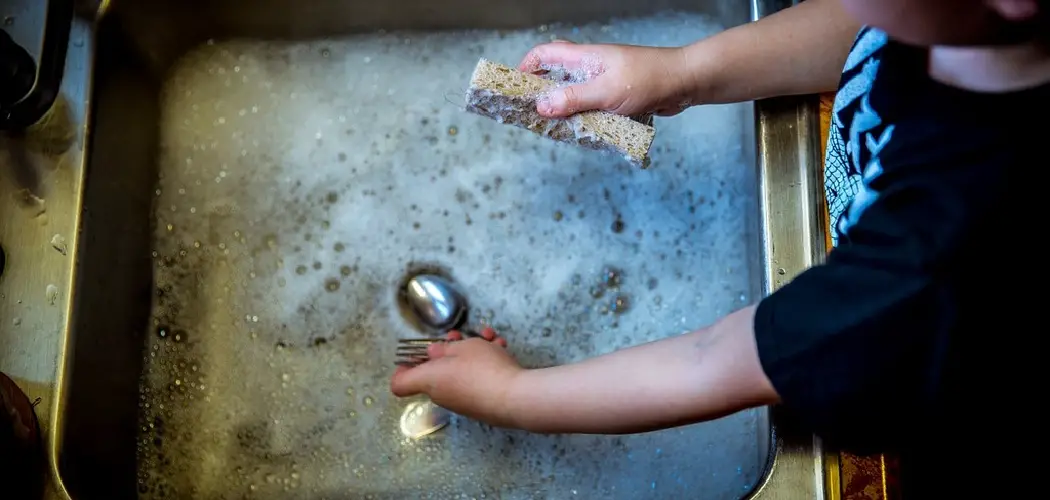Discovering mold growth under your sink can be alarming, but effectively cleaning it is essential for maintaining a healthy home environment. Mold thrives in damp, dark spaces, making the area under sinks a common target. In this comprehensive guide, we’ll explore effective strategies and practical tips on how to clean mold under sink.
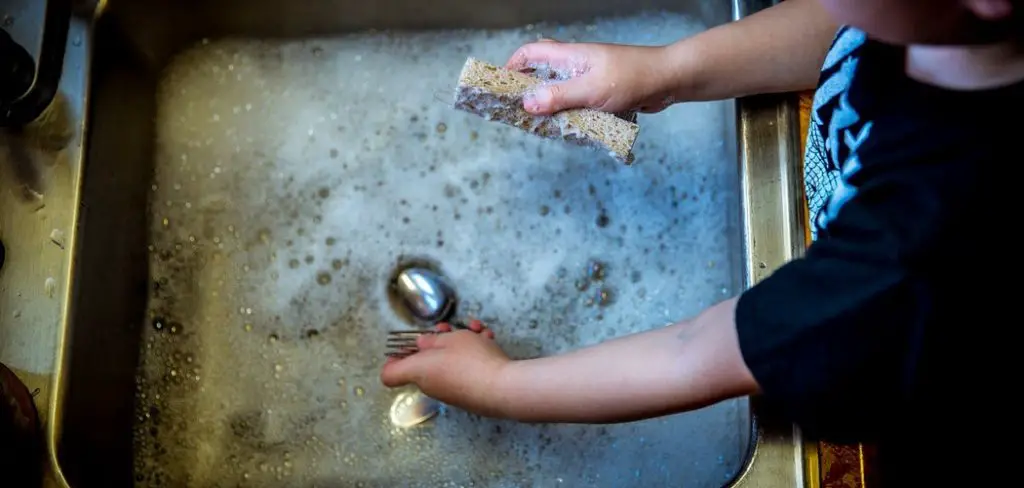
To tackle mold under the sink, it’s crucial to follow proper cleaning procedures to ensure thorough removal and prevent recurrence.This process involves gathering the necessary supplies, such as gloves, a mask, cleaning solution, and scrubbing tools, to protect yourself and effectively remove the mold.Additionally, identifying the cause of moisture, such as leaks or poor ventilation, is vital to prevent future mold growth.
Whether the mold is on surfaces like wood, plastic, or tile, specific cleaning techniques tailored to each material are necessary. By understanding how to clean mold under the sink properly, homeowners can safeguard their health, preserve their belongings, and maintain a clean and mold-free living space.
Common Occurrence of Mold Growth Under Sinks
Mold growth under sinks is a common issue faced by many homeowners due to the ideal conditions that these areas present for mold to thrive. The combination of moisture from leaks or condensation, limited airflow, and darkness creates a perfect environment for mold spores to settle and multiply. Kitchens and bathrooms are particularly susceptible, as sinks in these spaces are frequently used and are often tucked away in small, enclosed cabinets, making it difficult for the area to dry properly.
Furthermore, plumbing issues, such as leaking pipes or poorly sealed joints, can contribute to the persistent dampness that fosters mold growth. Regularly checking under sinks for signs of moisture and promptly addressing any issues can help mitigate the risk of mold development and maintain a healthier home environment.
Importance of Addressing Mold Promptly
Addressing mold growth under the sink promptly is crucial for several reasons. Firstly, mold can pose significant health risks, especially for individuals with allergies, asthma, or compromised immune systems. Inhalation of mold spores can lead to respiratory issues, skin irritation, and other allergic reactions. Secondly, mold can cause extensive damage to the structure and materials in your home. Left unchecked, mold can deteriorate wooden cabinets, compromise the integrity of drywall, and even damage plumbing fixtures.

Additionally, mold can lead to unpleasant odors that permeate your living space, affecting the overall indoor air quality. By tackling mold issues as soon as they are discovered, homeowners can prevent these potential health hazards, minimize property damage, and maintain a cleaner, healthier living environment. Taking immediate action also helps in identifying and fixing the underlying moisture problems, thus preventing future mold growth.
Understanding Mold Growth Under Sinks
To effectively combat mold growth under sinks, it is essential to understand the underlying causes and conditions that promote its development. Mold spores are a natural part of the environment and are present virtually everywhere, both outdoors and indoors. However, these spores require specific conditions to begin growing and forming colonies. The key factors that contribute to mold growth include moisture, organic matter, and a lack of ventilation.
Moisture is the most critical element for mold proliferation. Leaking pipes, condensation, or water spills under sinks provide a consistent source of dampness that mold needs to thrive. Additionally, organic matter found in dust, wood, and even some types of soap residues can serve as a food source for mold. The enclosed space under sinks often lacks proper ventilation, creating a stagnant environment where mold can flourish unnoticed for extended periods.
By comprehending these conditions, homeowners are better equipped to implement preventive measures. Regular inspections, ensuring proper sealing of plumbing fixtures, and maintaining good ventilation can significantly reduce the risk of mold growth. Understanding the environmental factors at play allows for more effective interventions, keeping the area under your sink dry, clean, and mold-free.
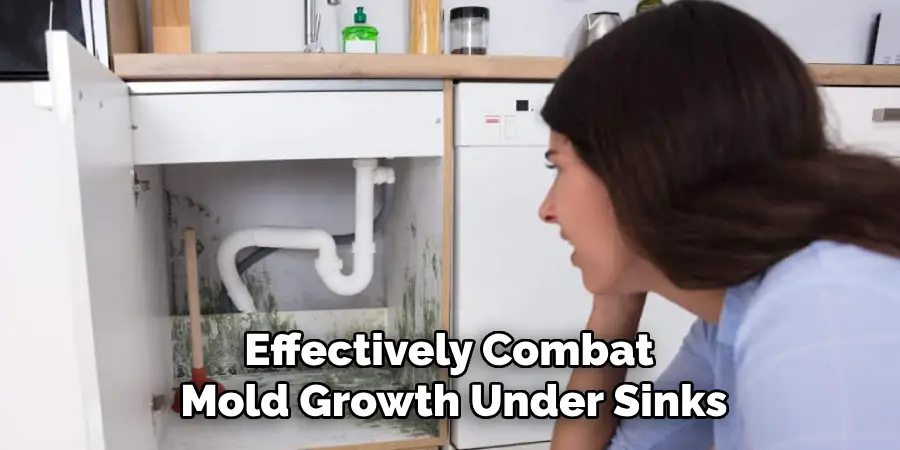
Causes of Mold Growth in Damp and Dark Environments
Mold growth is primarily driven by the presence of moisture and darkness, which create an ideal environment for mold spores to thrive. Dampness is the most critical factor contributing to mold proliferation. Leaks, spills, or high humidity levels can provide the necessary moisture for mold to grow. Even minor leaks from pipes, faucets, or sinks can lead to significant mold issues if not promptly addressed. Poor ventilation exacerbates this problem, as stagnant air prevents the area from drying out properly, further encouraging mold growth.
Another significant cause is the accumulation of organic matter, which serves as a food source for mold. Dust, wood, and certain types of residues can provide the nutrients mold needs to grow. The absence of natural light in dark areas under sinks or in enclosed spaces also contributes to mold colonization, as mold spores are more likely to proliferate in shaded, hidden environments where they are out of sight and undisturbed.
Understanding these causes is essential for preventing mold growth. By addressing sources of moisture, improving ventilation, and maintaining cleanliness in damp and dark areas, homeowners can significantly reduce the likelihood of mold development and maintain a healthier living environment. Regular inspections and timely repairs can also play a crucial role in keeping mold at bay, ensuring that these conducive conditions are promptly mitigated.
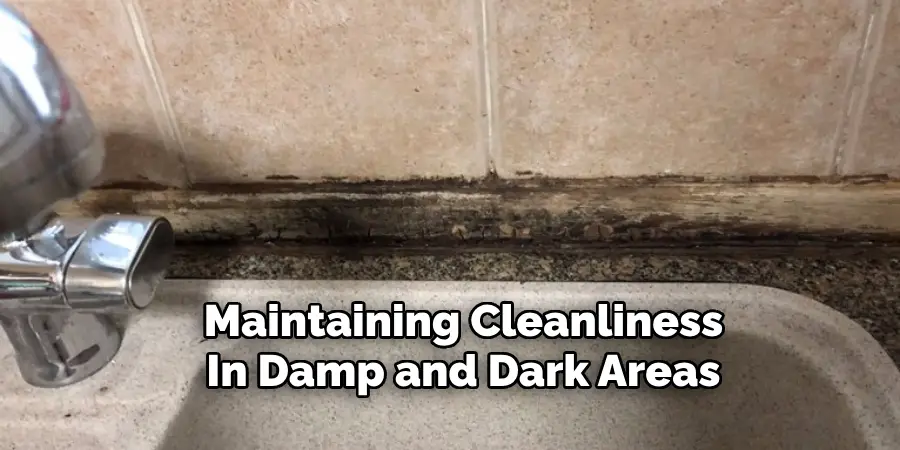
Common Areas for Mold Growth Under Sinks
Mold tends to form in specific areas under sinks, primarily driven by the presence of moisture and organic materials. One of the most vulnerable spots is around the base of the sink basin, where small leaks from the faucet or drain can accumulate. Such leaks often go unnoticed, allowing water to pool and create a damp environment perfect for mold proliferation.
Another common area is the bottom corners of the cabinet, where water can seep into crevices and remain undisturbed. If the cabinet is lined with wood or composite materials, these surfaces can absorb moisture and become an ideal substrate for mold spores to latch onto. Additionally, areas around plumbing fixtures, such as the joints and seals of pipes, are also susceptible to mold growth. These spots are often hidden and lack proper ventilation, providing mold with a secluded area to thrive.
Lastly, any stored items under the sink, such as cleaning supplies, rags, or sponges, can also foster mold growth if they become damp or are in contact with moisture. The combination of stagnant air, organic matter, and limited visibility in these storage areas creates a perfect breeding ground for mold. Regularly checking these common areas, along with maintaining cleanliness and ensuring proper sealing of fixtures, can significantly reduce the risk of mold development under sinks.
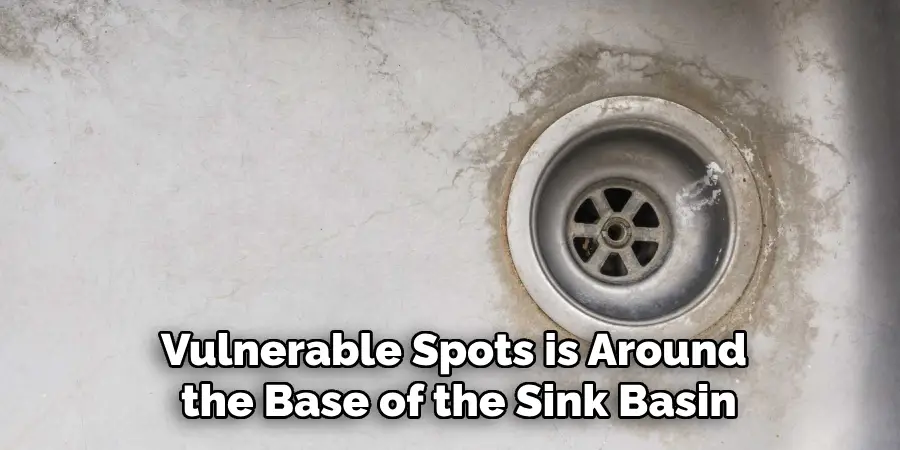
Safety Precautions Before Cleaning Mold
Before starting any mold cleanup efforts, it is crucial to prioritize safety to prevent potential health risks and further contamination. Here are some essential safety precautions to follow:
- Protective Gear: Wear appropriate personal protective equipment (PPE), including gloves, a long-sleeved shirt, long pants, goggles, and an N95 respirator or a mask designed to filter out mold spores. This will help prevent direct contact with mold and inhalation of hazardous spores.
- Proper Ventilation: Ensure good ventilation in the area where you will be working. Open windows and doors to provide fresh air and reduce the concentration of airborne mold spores. If possible, use fans to enhance airflow but avoid pointing them directly at moldy surfaces to prevent the spread of spores.
- Sealing Off the Area: Isolate the affected area by sealing off doorways and vents with plastic sheeting to contain mold spores and prevent them from spreading to other parts of the home. This minimizes the risk of cross-contamination.
- Avoid Disturbing Mold: Handle mold-infested materials carefully to avoid stirring up spores. Use a damp cloth or specialized cleaning agents to clean mold off surfaces gently, and never dry-brush or vacuum moldy areas with regular household equipment.
- Dispose of Contaminated Materials: Place moldy items and cleaning materials in sealable plastic bags before disposing of them. This ensures that mold spores do not escape during disposal and contaminate other areas.
- Keep Children and Pets Away: Ensure that children, pets, and individuals with compromised immune systems are kept away from the cleaning area. Avoiding exposure to mold is crucial for sensitive individuals.
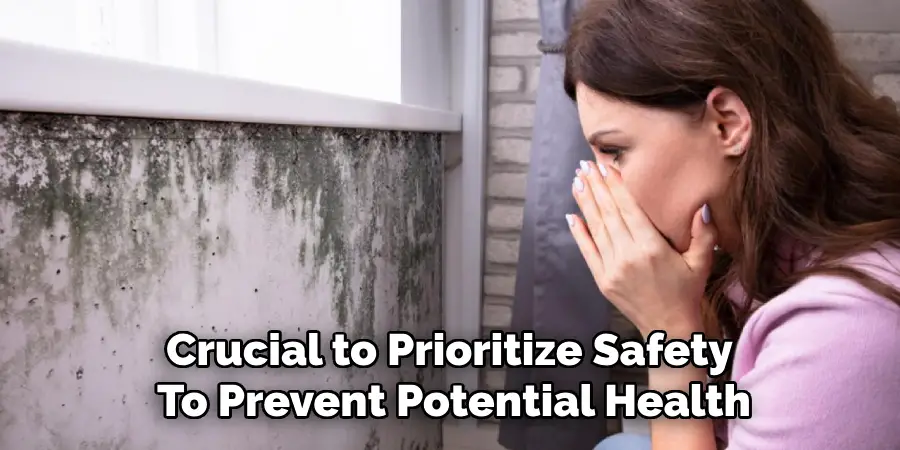
By adhering to these safety precautions, you can mitigate health risks and effectively manage mold cleanup efforts, ensuring a safer and healthier living environment.
10 Methods How to Clean Mold under Sink
1. Prepare the Area with Deliberate Care and Attention:
Begin the process of addressing mold under the sink with a meticulous approach to preparation. Take the time to clear out the cabinet, ensuring all stored items are removed to provide unobstructed access to the affected area. By creating a clear workspace, you allow yourself the freedom to maneuver effectively and address the mold growth comprehensively. Lay down protective coverings such as old towels or plastic sheets beneath the sink area to safeguard the floor and nearby surfaces from potential mold spores and cleaning solutions, underscoring a commitment to both thoroughness and safety.
2. Prioritize Personal Safety:
Before delving into the cleaning process, prioritize personal safety by donning appropriate protective gear. Equip yourself with sturdy gloves to shield your hands from direct contact with mold and cleaning solutions. Additionally, wear safety goggles to protect your eyes from any splashes or airborne particles, and use a respiratory mask to minimize inhalation of mold spores and chemical fumes. Emphasizing safety measures not only protects your health but also ensures a focused and undisturbed cleaning process.
3. Methodical Inspection and Identification:
Conduct a methodical inspection of the mold-infested area beneath the sink, employing both visual examination and tactile assessment to gauge the extent of contamination. Utilize a flashlight to illuminate dark corners and crevices, as mold often thrives in dimly lit and moisture-rich environments. Pay close attention to the type and severity of mold present, noting any discoloration, musty odors, or visible signs of moisture damage. This careful inspection serves as the foundation for devising an effective cleaning strategy tailored to the specific needs of the situation.
4. Implement Strategic Containment Measures:
Implement strategic containment measures to prevent the inadvertent spread of mold spores to other areas of the home. Seal off the affected area under the sink using durable plastic sheeting or containment barriers, securing them in place with strong adhesive tape. By creating a temporary enclosure, you minimize the risk of cross-contamination and maintain a controlled environment conducive to focused mold remediation efforts. This deliberate approach underscores a commitment to thoroughness and precision in addressing the issue at hand.
5. Choose and Apply Mold Removal Techniques with Precision:
Select and apply mold removal techniques with precision and care, taking into account the nature of the affected surfaces and the severity of the contamination. Choose an appropriate cleaning solution suited to the materials involved, whether it be a mild detergent and water mixture, vinegar, hydrogen peroxide, or a commercial mold remediation product.
Apply the chosen solution to the mold-infested surfaces using a sponge, brush, or spray bottle, ensuring thorough coverage and attention to detail. By approaching the cleaning process with precision and intentionality, you set the stage for effective mold removal and remediation.
6. Engage in Vigorous Scrubbing and Agitation:
Engage in vigorous scrubbing and agitation of the mold-infested surfaces to dislodge and remove stubborn mold spores embedded within porous materials such as wood, drywall, or grout. Arm yourself with a stiff-bristled brush or abrasive scrubbing pad, applying firm pressure as you work to break apart and remove mold stains. Work in small, manageable sections, rinsing the brush or sponge frequently to prevent recontamination and ensure thorough cleaning.
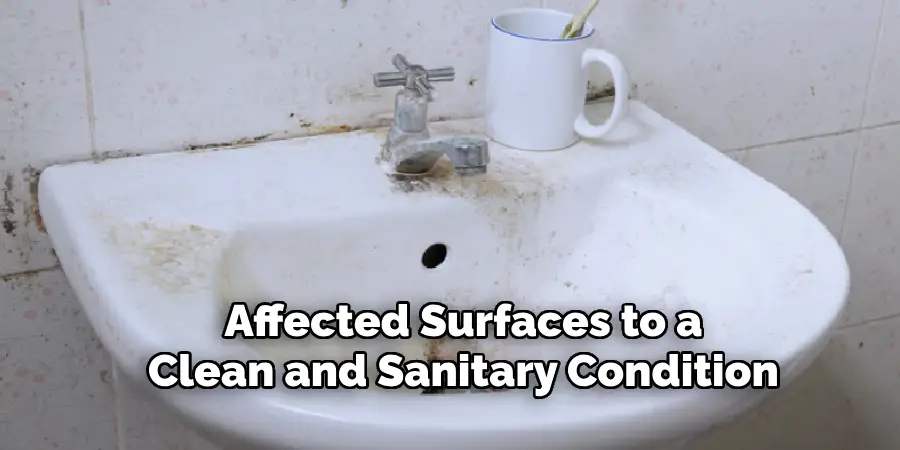
This deliberate approach to scrubbing and agitation helps to ensure the comprehensive removal of mold growth and restore the affected surfaces to a clean and sanitary condition. Though this method may require more physical effort, it is a crucial step in the mold remediation process. In addition to vigorous scrubbing and agitation, it is important to also pay attention to hard-to-reach areas such as corners, crevices, and tight spaces. Mold has a tendency to spread quickly and can easily hide in these hidden spots.
7. Thorough Disinfection and Sanitization:
Follow up the mold removal process with a thorough round of disinfection and sanitization to eliminate any lingering mold spores and inhibit future growth. Prepare a solution of bleach diluted with water or utilize a commercial disinfectant, applying it generously to the cleaned surfaces with a sponge or cloth. Allow the disinfectant to dwell for the recommended period before rinsing the area thoroughly with clean water. By prioritizing thorough disinfection and sanitization, you create an inhospitable environment for mold growth and promote long-term cleanliness and hygiene.
8. Facilitate Drying and Dehumidification:
Facilitate the drying and dehumidification of the cleaned area beneath the sink to prevent residual moisture buildup and discourage mold regrowth. Utilize fans, dehumidifiers, or natural ventilation to promote air circulation and expedite the drying process. Pay careful attention to all surfaces and materials, including the interior of cabinets, pipes, and plumbing fixtures, ensuring they are thoroughly dried to eliminate any lingering moisture. By prioritizing effective drying and dehumidification, you mitigate the risk of mold recurrence and create an environment conducive to long-term cleanliness and hygiene.
9. Conduct a Comprehensive Inspection and Ongoing Monitoring:
Conduct a comprehensive inspection of the cleaned area beneath the sink to ensure the complete removal of mold and the restoration of a clean and sanitary environment. Utilize a flashlight to examine hidden or hard-to-reach areas, checking for any signs of remaining mold growth or moisture accumulation. Implement ongoing monitoring protocols to regularly assess the condition of the area and identify any potential signs of mold recurrence or water damage. By maintaining a vigilant approach to inspection and monitoring, you can address any emerging issues promptly and prevent the reoccurrence of mold-related problems.
10. Proactive Preventive Maintenance Measures:
Implement proactive preventive maintenance measures to mitigate the risk of mold growth and moisture-related issues beneath the sink in the future. Address any underlying causes of moisture buildup, such as plumbing leaks or inadequate ventilation, and implement appropriate remedial actions to prevent recurrence.
Establish a regular cleaning and maintenance schedule to keep the area beneath the sink clean and dry, thereby minimizing the likelihood of mold growth. By adopting a proactive approach to preventive maintenance, you can create a healthy and hygienic environment that promotes the well-being of you and your household.
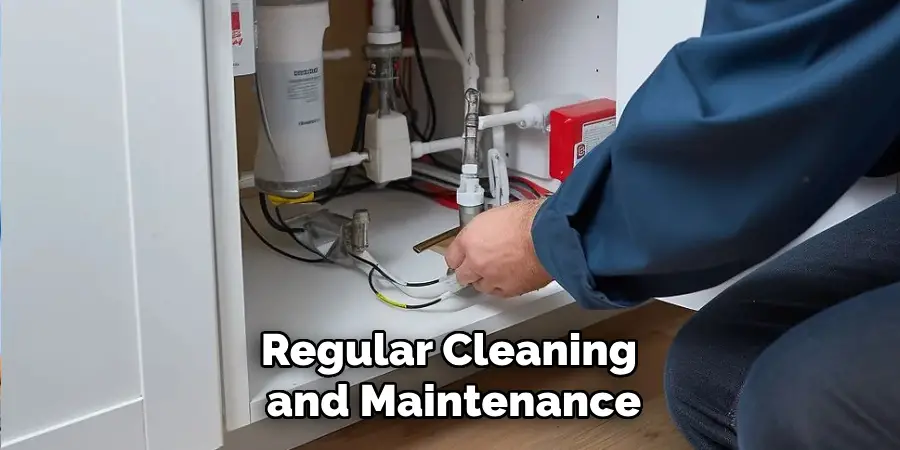
Conclusion
Addressing mold growth beneath the sink requires a methodical and thorough approach to ensure its complete removal and to prevent future occurrences. Each step, from initial assessment and containment to meticulous cleaning, disinfection, and drying, plays a critical role in maintaining a healthy and mold-free environment. By implementing these strategic measures and adopting proactive maintenance practices, homeowners can safeguard their living spaces against the detrimental effects of mold, thereby promoting long-term cleanliness, health, and well-being.
Dedication to these practices not only resolves current mold issues but also lays the groundwork for enhanced indoor air quality and a safer, more hygienic home. Hopefully, this article gave you some helpful tips about how to clean mold under sink successfully, so now that you have the proper knowledge on how to get the job done, why not give it a try today?

